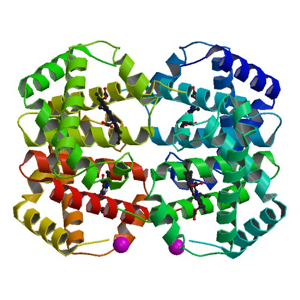For each of the following questions select the best answer.
| 1. |
Biological macromolecules, such as proteins, nucleic acids, carbohydrates and lipids are primarily composed of
|
|
|
| 2. |
A hydrogen bonding interaction can be described as is
|
|
|
| 3. |
Protein building blocks are called
|
|
|
| 4. |
A peptide bond is formed as a result of a/an _____________ reaction between two amino acids?
|
|
|
| 5. |
When an enzyme changes its structure upon binding a substrate the following has changed:
|
|
|
| 6. |
The 3D structure of a protein can NOT be determined using which of the following methods
|
|
|
| 7. |
The ribbon diagram of a protein structure shows which of the following?
|
|
|
| 8. |
Which of the following resources is a primary resource for 3D structural data of biological macromolecules?
|
|
|
| 9. |
Visualization and analysis of a protein structure is NOT useful in
|
|
|
| 10. |
The structure shown below is that of
 |
|
|